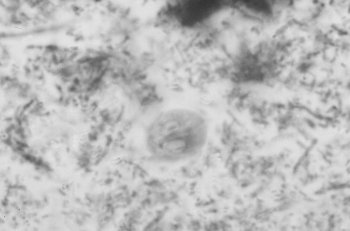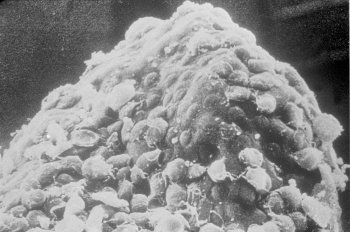| Life cycle of Giardia | Species of Giardia | How do dogs get Giardia ? | Can people get Giardia from dogs? | What harm does Giardia do to dogs? | How to know when a dog has Giardia | How to be sure a dog has Giardia | How to treat a dog for Giardia
Giardia spp. are parasitic protozoans (single celled organisms) found in the intestines of many animals, including dogs. This microscopic parasite clings to the surface of the intestine or floats free in the mucous lining the intestine.
The prevalence of Giardia in dogs of Alberta is not known. However, rates of 5 to 10 per cent have been suggested. This level is consistent with those reported in surveys from the United States and many other countries.
Life cycle of Giardia
Giardia occurs in two forms:
- a motile feeding stage that lives in the intestine
- a non-motile cyst stage that passes in the feces
Encystment occurs as the parasite travels to the large intestine. The cysts are fairly resistant and can survive for several months as long as sufficient moisture is provided. Mature cysts are usually found in the feces of infected animals.
Animals become infected by ingesting cysts. These cysts break open in the intestine to release the motile feeding stage (trophozoite). Giardia increase their numbers by each organism dividing in half repeatedly by a process called binary fission.
Species of Giardia
Species of Giardia are morphologically similar. It was customary to give each Giardia a different name when it was found in a new host. For example, the Giardia in dogs was called Giardia canis, in cattle, Giardia bovis, and so on.
Today, scientists believe that few species occur, and each species can infect more than one host. However, more research is needed on identifying each species and determining the hosts they can infect.
How do dogs get Giardia ?
Giardia is transmitted from host to host by ingesting cysts in contaminated feed or drinking water. Cysts may also be found in streams or other water sources.
The trophozoite stage may also be infective to dogs. This stage does not survive for very long after being voided in the feces. Therefore, it probably does not contribute significantly to the transmission of Giardia.

Figure 1. Giardia spp. as seen in a fecal smear.
Can people get Giardia from dogs?
Giardia can infect humans. The clinical signs are similar to those reported for dogs. We do not know the significance companion animals serve as a source of infection for humans. Until it has been proven otherwise, we should assume that Giardia can be transmitted from one animal to another and from other animals to humans.
What harm does Giardia do to dogs?
The significance of Giardia in dogs is still not certain. Although Giardia has been reported from dogs with diarrhea and dysentery, it has also been reported in apparently healthy dogs.
Clinical signs usually occur in dogs less than one year of age. But giardiasis may also occur in older dogs, or in animals suffering from other diseases or those undergoing chemotherapy.

Figure 2. Scanning electron micrograph of Giardia attached to the inner surface of the intestine.
How to know when a dog has Giardia
Clinical signs range from none in asymptomatic carriers, to mild recurring diarrhea consisting of soft, light-colored stools to acute explosive diarrhea in severe cases.
Other signs associated with giardiasis are weight loss, listlessness, mucus in the stool and anorexia. These signs are also associated with other diseases of the intestinal tract and are not specific to giardiasis.
How to be sure a dog has Giardia
Diagnosis is confirmed by finding the cysts or motile stages in feces. A negative report does not rule out Giardia.
Because cysts are only passed periodically, several fecal examinations may be necessary to diagnoses this parasite. At least three fecal samples, examined over a period of seven to ten days, should be examined.
How to treat a dog for Giardia
There are two antiprotozoal drugs commonly recommended (metronidazole and quinacrine). Contact your veterinarian for the drug of choice and treatment program. All infected animals should be treated whether or not they show clinical signs.
Prepared by:
Murray J. Kennedy
Food Safety Division
Source: Agdex 663-31. Revised April 2001. |